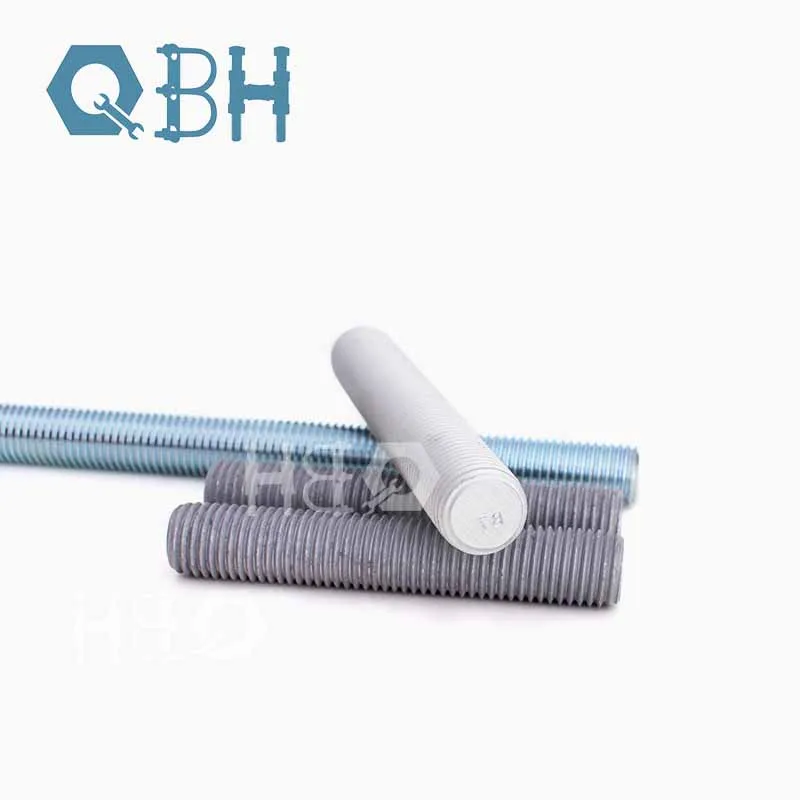What safety precautions should be taken when using thread rods?
2024-10-11
Threaded rods are versatile, widely used components in construction, manufacturing, and even DIY projects. But what often flies under the radar are the safety precautions required to handle these unassuming metal rods safely. Improper usage, storage, or installation of threaded rods can lead to accidents, project failures, or even severe injuries. In this blog, we go beyond the usual checklists and take a more comprehensive look at how to ensure safety when working with threaded rods, focusing not only on physical safety but also the broader operational environment.

1. Understand the Material and Application Context
Before diving into the physical handling of threaded rods, it's important to understand the specific material you're working with and how it fits into the overall project. Threaded rods come in various materials like stainless steel, carbon steel, and brass, each with its own mechanical properties, such as tensile strength and corrosion resistance. This impacts how they should be handled and installed.
Why It Matters:
- Carbon Steel Rods may rust if left exposed in damp environments, potentially weakening structural integrity over time.
- Stainless Steel Rods, though rust-resistant, can have a sharp thread that could cause injuries if not handled properly.
Safety Tip: Always check the material specifications before use. If the rod is not suitable for the environment (e.g., outdoor, humid conditions), you might compromise safety. Select rods with coatings or properties tailored to the environment.
2. Proper Storage to Prevent Hazards
Improper storage of threaded rods can create unforeseen hazards in the workplace. Rods that are poorly stored can cause tripping hazards, accidental drops, or even roll-offs from elevated surfaces.
Key Storage Precautions:
- Secure Placement: Store rods horizontally in racks or vertical bins that prevent them from rolling. For longer rods, ensure they are adequately supported at intervals to avoid bending or falling.
- Sharp Edges: Be mindful of the threaded sections, which can cause cuts or snagging on clothes. Use rod caps on exposed ends or store rods in a way that minimizes direct contact with these sharp threads.
Safety Tip: Use clearly marked storage areas to avoid unintentional exposure to hazardous materials and minimize tripping risks in high-traffic zones.
3. Personal Protective Equipment (PPE) Specific to Threaded Rods
While gloves and safety goggles are common across many construction tasks, working with threaded rods often demands a more nuanced approach to personal protective equipment (PPE).
Recommended PPE:
- Cut-Resistant Gloves: Threads on rods are sharp and can easily cause lacerations during handling or installation. Gloves made from Kevlar or similar cut-resistant materials are recommended.
- Safety Glasses: Cutting or grinding threaded rods can cause small metal particles to fly off, posing a significant risk to the eyes.
- Protective Footwear: Long rods that aren’t secured properly can fall or roll, leading to foot injuries. Steel-toed boots provide the necessary protection.
Safety Tip: When threading or cutting rods, ensure that PPE specific to eye and hand protection is used at all times. Avoid wearing loose clothing that could get caught on the rod’s threads.
4. Handling and Lifting Techniques
Threaded rods, especially longer ones, can be awkward to handle due to their weight distribution and tendency to roll or slip. Improper handling can lead to musculoskeletal injuries or dropped objects.
Safe Lifting Practices:
- Use Mechanical Aids: For longer, heavier rods, use cranes, forklifts, or other mechanical aids rather than lifting by hand. Avoid overexertion and awkward postures that could strain your back or arms.
- Lift with a Partner: If mechanical aids are not available, use team lifting techniques to distribute the weight and ensure steady handling.
- Secure Rods Before Moving: If transporting threaded rods in a vehicle or on-site, make sure they are properly secured to avoid movement that could lead to accidents.
Safety Tip: Never carry rods over your shoulder, especially on busy job sites. This reduces visibility and creates a swinging hazard that could injure others.
5. Thread Rod Cutting Precautions
Threaded rods often need to be cut to size for custom applications. While this might seem like a routine task, cutting rods poses a variety of hazards, from flying debris to improper thread formation.
Cutting Safety Guidelines:
- Use Proper Tools: Cutting rods with the wrong tool can result in uneven threads or jagged edges, increasing the risk of injury and making the rod unsuitable for the project. Use a hacksaw, angle grinder, or a rod cutter designed specifically for the material.
- Secure the Rod: Before cutting, ensure the rod is securely clamped to avoid any shifting during the process, which can result in uneven cuts or injury.
- Deburr the Edges: After cutting, the ends of the rod will likely have sharp burrs that can cause cuts. Always deburr the edges with a file or grinder to smooth out these sharp areas.
Safety Tip: Always wear full face protection when cutting rods to avoid flying metal debris. After cutting, check the thread for any damage or deformities that could compromise the rod’s structural use.
6. Threaded Rod Installation: Reducing Structural Risks
Once the rod is ready for installation, attention shifts to ensuring that the application process is safe and precise. Incorrect installation can cause structural failure, creating long-term safety issues.
Installation Best Practices:
- Torque Guidelines: Threaded rods often require precise torque during tightening. Over-torquing can lead to stripping the threads, while under-torquing may result in a weak joint. Follow manufacturer specifications for the correct torque.
- Proper Alignment: Misaligned rods can lead to poor load distribution, increasing the risk of joint failure. Always ensure the rod is aligned correctly before tightening.
- Vibration and Load Considerations: If the rod is being used in environments subject to heavy loads or vibration (e.g., machinery mounting), use locking mechanisms like thread-locking compounds or lock washers to prevent loosening over time.
Safety Tip: Always check installation with calibrated tools to ensure torque settings are accurate and consistent, reducing long-term structural risks.
Threaded rods may seem like a small part of a larger project, but they can introduce significant safety risks if not handled and installed properly. By understanding the material, using proper tools, and implementing careful handling techniques, you can mitigate risks and ensure a safer work environment. Taking the time to train personnel and secure the workspace not only improves safety but also contributes to the overall success and durability of your project.
Jiaxing City Qunbang Hardware Co, Ltd. is a production/design/sales and after-sales as one of the fasteners business. Check out our website at https://www.qbhbolt.com for more information about our products. If you have any questions, feel free to contact us at sales@qbfastener.cn.




